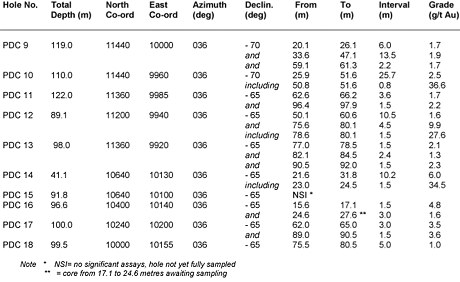September 22, 2003
CORE DRILLING CONFIRMS GOLD MINERALISATION EXTENDS TO DEPTH AT MAIN ZONE, BAMBARI PERMIT, CENTRAL AFRICAN
Toronto, Ontario – AXMIN Inc. (AXM-TSX Venture) Venture) is pleased to report that core drilling at the Main Zone prospect within the Bambari Permit in the Central African Republic (“CAR”) has confirmed that the multiple gold bearing structures within this extensive mineralised system extend to depth. It has also provided valuable information on the ore controls. Intersections from ten widely spaced drill holes include 25.7 metres grading 2.5 g/t Au, 10.2 metres grading 6.0 g/t Au and 4.5 metres grading 9.9 g/t Au. Individual structures include 1.5 metres assaying 34.5 g/t Au, 1.5 metres assaying 27.6 g/t Au and 0.8 metres assaying 36.6 g/t Au. A full listing of intersections received to date is given in the attached table.
The Main Zone is the third prospect where core drilling has confirmed the presence of gold mineralisation at depth. The French Camp, Katsia and Main Zone prospects, which lie within three kilometres of each other all have the potential to host open pittable resources. In addition, previous rotary air blast (“RAB”) drilling has defined several nearby anomalies of similar character that remain to be tested. Moreover, earlier work has identified three other substantial centres of mineralisation across only a small part of the 2,000 sq km licence with very similar underlying geology.
Chief Executive Officer, Dr Jonathan Forster comments that “These results from the widely spaced scoping holes confirm that the mineralisation previously recognised at Main Zone through surface sampling and reverse circulation (“RC”) drilling persists to depth. The greater precision of core drilling has also allowed us to recognise structures that in places carry extremely high grades.”
Dr Forster continues “The results of our recent core drilling provide strong support for our long held conviction that we are dealing with a major new gold belt which with continuing exploration and under the new mining code currently before parliament may be capable of supporting CAR’s first major gold mine. In the near term our major task is to concentrate on the definition of sufficient resources of economic grade to justify the initiation of a feasibility study to which end we will shortly be starting our first phase with the previously reported 15,000 metre drill program. We propose to mobilise a second core rig and a reverse circulation rig from South Africa to accelerate this work.”
Main Zone was previously delineated over a strike length of 1,600 metres by shallow RC drilling as comprising multiple mineralised structures of widths varying from 1 metre to 20 metres within a corridor 200 metres wide. Soil sampling and shallow RC and RAB drilling indicate that the mineralisation could well extend an additional 1,500 metres to the northwest and at least 800 metres to the southeast to give a potential total strike length of nearly 4,000 metres.
The 10 hole core drilling program reported here was non-systematic, with individual drill holes testing specific sites along the central 1,600 metre by 200 metre corridor to provide information on the geological controls to mineralisation. This was designed to facilitate the planning of subsequent drill programs to define resources and reserves. The core drilling has demonstrated that the gold bearing structures, where correlated with intercepts from shallow RC holes, typically dip more steeply to the southwest than anticipated. In some instances it is likely that the holes failed to reach the zones targeted. In contrast to the French Camp and Katsia prospects where gold mineralisation lies within or adjacent to massive units of Banded Ironstone Formation (“BIF”), the initial interpretation at Main Zone places gold mineralisation within acid to intermediate schists with only minor BIF units. This host package of lithologies has been subject to strong shearing so individual bodies of mineralisation may be more complex.

Assay intervals are calculated using a 1 g/t Au cut off. Higher grades remain uncut as evidence so far from this and earlier RC drilling suggests that narrow zones of high grades are not unusual and a larger database will be needed before a statistical determination for grade cutting can be established.
These grade calculations are based on the initial assays received from the laboratory, which will be subject to a quality control program. Analytical work is being carried out at independent OMAC Laboratories Ltd. in Ireland. The core samples are subject to a full sample preparation followed by a 50 gram fire assay with an AA finish. Core blanks (5%) are being used to monitor laboratory performance during first pass analysis. A full QA/QC program will be coordinated on 20% of all >500 ppb samples at the end of the program and will include 5% standards and duplicates. This press release has been reviewed by an in-house qualified person, Dr Jonathan Forster, Fellow of the Institute of Mining and Metallurgy.
AXMIN is a mineral exploration company with a strong focus on gold in highly prospective properties across Africa, principally in the Central African Republic, Burkina Faso and Mali. |